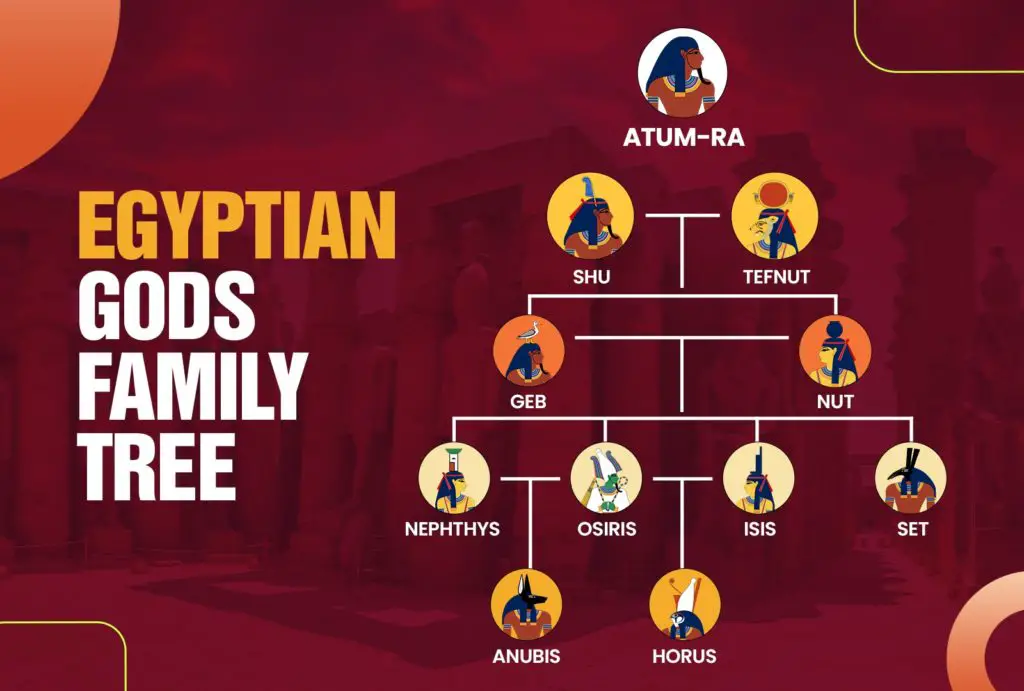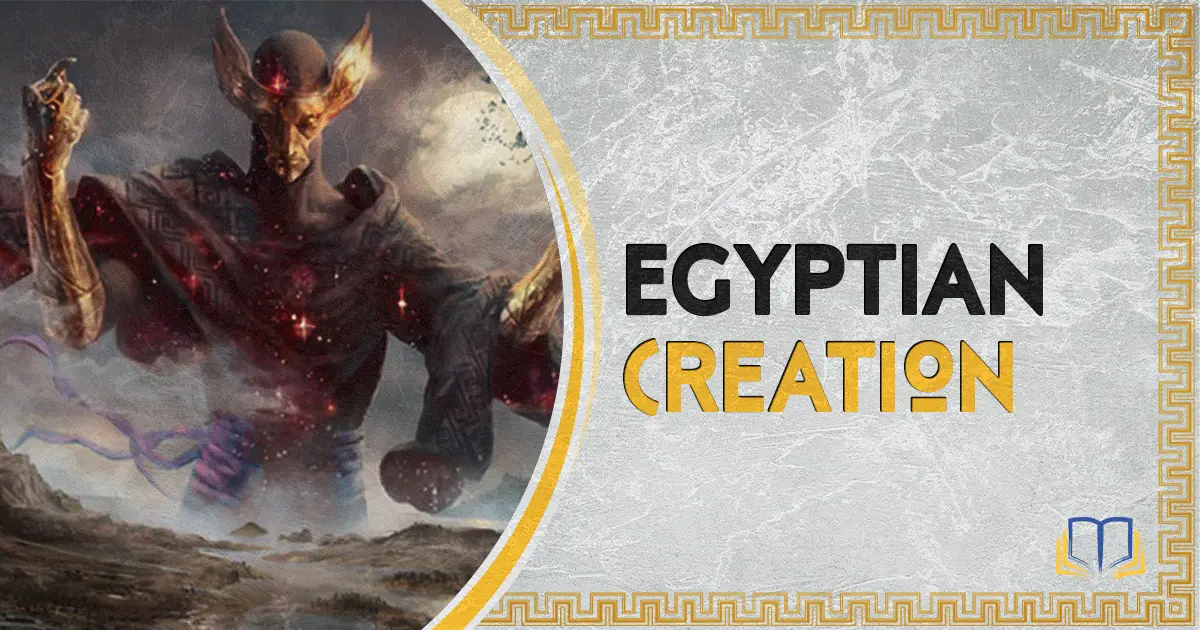Egyptian mythology has a way of getting complicated.
We tend to think of Egyptian mythology as a cohesive piece of related stories, but in fact these stories vary wildly. Such is the case with the creation myth.
Depending on where and when you lived, you may have heard the creation story differently. You may have believed the god of creation was Atum, or you may have believed in Ra, or a number of others.
In this way, multiple Egyptian gods served the same function, depending on the region and time period. Likewise, you could also have one god serving wildly different functions for the same reasons.
Nevertheless, there are similarities between the myths. For example, a sun god is almost always present at the dawn of creation. There’s just some disagreement about who that sun god was.
In this article you will learn:
- The story of the creation myth, including common elements like chaos, the creator, and the act of creation
- Who the Egyptian creator god was
- Where the different sources of the myth come from
Also, don’t forget to visit our Egyptian Mythology hub, where we have a LOT more articles like this one.
Summary of the Egyptian Creation Myths
What follows is our summary of the different creation myths of ancient Egypt, broken down into the shared themes.
Want to see more videos like this one? Subscribe to my YouTube channel so you don’t miss the next story!
Chaos
In the beginning, there was nothing but a dark, watery domain of nothingness. It was both nothing and everything, and in no place was there anything but the nothingness.
In Egyptian myth, this nothing became personified as Nu or Nun.
Interestingly, even though Nun would eventually give way to creation, he/it was still thought to exist beyond the boundaries of the world, living still. It was from Nun that the waters of the Nile were thought to originate.
In the beginning, there was nothing but a dark, watery domain of nothingness.
Tweet
In a way, Nun was the father of all, because even the creator came out of Nun.
While it’s unclear at what point Nun became personified in ancient Egyptian culture, we do know that he is not the only personified aspect related to the creation story.
In one version of the story, aspects of Nun were given personality and eventually formed the Eight, or the Ogdoad of Hermopolis.
This Ogdoad had to either change or die in order for creation to happen.
When they came into the world, there were four males and four females. The males were amphibious in nature and the females were reptilian, as these were the creatures thought to inhabit the primeval waters of nothingness.
Each male was paired with a female:
- Amun and Amunet: representing the unknowable quality of the water, presented through elements like air and invisibility
- Heh and Hehet: represented just how boundless the water was
- Kek and Keket: representing the darkness associated with the watery abyss
- Nun and Naunet: representing the primeval water itself
In this version of the creation myth, these couples became the fathers and mothers of all that exists.
Amun would later grow in prominence, sometimes said to be the father of the Eight, despite the fact that they all came out of Nun.
In some versions Amun was the sun god who would eventually lead creation.
The Emergence of a Creator
The creator is one figure with many faces, depending on the time period where a myth was born, and the region. But in almost all cases, the creator was a sun god.
At some point in the midst of the chaos, the creator emerged. There were a variety of ways this happened:
- He was born of a cow
- He emerged from a lotus flower on the water
- He emerged from a cosmic egg
- He alighted as a bennu bird onto the first emerging solid land
Regardless of how it happened, there is an emphasis that the creator was a “self-created” god.
In the Coffin texts, this god was Atum, who brings forth the other eight Ogdoad of Hermopolis by discoursing with Nun and naming them, thereby giving definition to the attributes that the Eight embodied.
Sometimes the creator god was referred to as “The one who made himself into millions,” signifying that this god would eventually bring all of creation into existence.
The Egyptian creator is a figure with many faces, but in almost all cases, the creator was a sun god.
Tweet
Paradoxically, there were certain gods said to be with the creator in the beginning, enabling him to come into being, or gain the ability to create things by naming them. Examples of these dieties include:
- Hu: the word the creator used to begin creation
- Sia: the embodiment of perception and intelligence
- Heka: the god of magic and ritual, said in the Coffin Texts to exist “before duality had yet come into being”
But who was the creator?
We’ve already mentioned Atum, the Pyramid texts describe him as masterbating and asexually creating twins Shu (god of air) and Tefnut (goddess of moisture). The Coffin Texts say they came from his breath.
Ptah was another creator deity worshiped in the early New Kingdom, as per the Memphite Theology. Not only was he the creator, but he was also a craftsman.
Khnum was one more creator being, sometimes said to have created the gods and depicted with a ram’s head. He was also sometimes shown as a craftsman who made things at the command of a different creator.
Ra is yet another important sun god in the role of the creator. He is probably best known today.
Other sun gods who fulfilled the creator role in some way include:
- Khepri: a scarab-faced god representing the rising sun
- Aten: representing the actual disc of the sun
- Amun: representing invisibility and air, later merged with Ra to become Amun-Ra
- Horus: god of the sky
Creator deities were often depicted as existing without gender, described as both the father and mother of all things.
In the case of Atum, he becomes male after giving birth to his children: Shu and Tefnut.
Regardless of how he enacts creation or in what way, once the creator is born, and the primordial mound emerges from the waters, space is given for creation to occur.
Creation
The actual events of creation were not thought of as comprehensible in Egyptian culture.
As such, there have been many descriptions of it through the ages, but none of these were necessarily meant to contain fact, but to rather represent something we humans are incapable of comprehending.
Creation is usually divided into a few important key events:
- The emergence of creator from primeval waters
- The creation of gods
- The establishment of Maat, the Egyptian concept of order, often deified
- The division of beings into male and female
- The separation of earth and sky
The Beginning
The First Act is usually the coming of light, or a ray from the sun, sometimes represented as an eye, a child, or a fiery bird.
In the Coffin Texts, the creator is described as sending out an eye to find new life amidst the chaos. From the New Kingdom and onward, the newborn sun was depicted as a child or a ram-headed figure.
Sometimes the sun was actually a cosmic egg, laid by a primeval bird. That bird is what originally breaks the silence, bringing both the first light and the first sound to the world.
This bird is called a bennu bird, and becomes largely associated with the gods, and is thought to be the origin of the phoenix in Greek Mythology.
The Primeval Mound or Benben
At some point in the creation myth, a primeval mound will appear, separating from the dark waters of Nun. This mound is also called a benben.
A benben is a term also used for the top of an obelisk or the very top of a pyramid, thus this primeval mound had great symbolic significance to the Egyptians.
The First Gods
Once the creator emerged, he created the first gods. For Aten, this was done by masterbating and asexually producing children. In later texts, it would be described as breathing out and the gods coming out of his breath. In still later texts, the two would be combined, where Aten would swallow his own seed, thereby impregnating his breath and giving birth by breathing out.
The hand that does this was later personified as a goddess, the Hand of Atum, often equated with the goddess Hathor.
Regardless of how it happened, the first two children are:
- Shu: the god of air
- Tefnut: the goddess of moisture
In the Coffin Texts, Atum becomes separated from Shu and Tefnut, and he sends his eye to seek after them. When he finds them again, his tears create the first humans.
Together, the three of them are often described as being one person, inseparable until the act of creation separates them.
The creator would then go on to create many more gods, including Thoth and Maat (the living embodiment of the Egyptian concept of order and goodness). Maat was said to be the creator’s favorite daughter, though she was also associated with Shu and Tefnut.
The Separation of Earth and Sky
Eventually Shu and Tefnut would join and have children of their own: Geb and Nut, representing earth and sky, respectively.
Geb and Nut were also in love, and together they were entwined so tightly that nothing could exist. To solve this problem, Shu separated his children, so that Nut was arched above Geb (like the sky is above the Earth), never again to meet.
This separation, however, allowed Geb and Nut to bear children. Nut gave birth to several of the most important deities in the Egyptian pantheon:
- Osiris
- Seth
- Isis
- Nephthys
- Horus (in some sources)

This separation of earth and sky is one of the most important events in the creation of the world, as it allowed life to flourish and gave birth to the Egyptian cosmos.
The Egyptians viewed the cosmos as being divided into an upper sky, the world beneath, and the Underworld below, called the Duat or Dat.
The Creation of Humans
Humans are created after all these events, though their creation is not prominent in Egyptian texts. Their existence is mentioned as more of an afterthought, and there is not a lot of cohesion between ideas.
For example, in one version they are said to come from Atum’s tears upon reuniting with his lost twins. But in other versions, humans are not created until after the separation of earth and sky.
Regardless, the origin of humans seemed to be less important to the Egyptians than it was to many other cultures in their mythologies.
Sources of the Creation Myths
Most creation myths were associated with the worship of a particular god, usually centered around one of the larger cities in Egypt.
It is from this separation that we get the conflicting versions of the story, along with the different identities of the creator god.
There were four primary sources of these myths:
Hermopolis
Hermopolis was a major city located near the border of Lower and Upper Egypt, and is the source of the myth outlining the eight gods of the Ogdoad.
This is the part of the myth where the Ogdoad came into existence, four male and four female, each representing different parts of the primordial waters.
Together they created the first landmass and the sun, sparking creation.
Heliopolis
Heliopolis was another major city, this time located in Lower Egypt. It’s location is now a suburb of modern-day Cairo.
The myth originating near this city center revolved around Atum. This is the story that gives us the birth of Shu and Tefnut, Geb and Nut, and eventually the entire pantheon that included such deities as Osiris, Set, Isis and Nephthys.
Memphis
Memphis was another major city in ancient Egypt, located in Lower Egypt in a strategic position near the Nile Delta.
From Memphis came the myth of Ptah, one of the more prominent figures of creation besides Atum and Ra.
Ptah was a god of craftsmen, and his creation story is different in that the creation is intellectual instead of physical. By imagining creation then speaking the names of his ideas, they came into being.
The myths surrounding Memphis and Heliopolis coexisted, and those in Memphis imagined Ptah as a god above Atum, being the one that brought Atum into existence.
Thebes
Thebes was a major city located deep in Upper Egypt, close to Nubia. It was the capital and cultural center of Egypt for a long time.
In Thebes, the major creation myth revolved around Amun, who in this version was not just a member of the Ogdoad, but also its creator.
Because of Thebes’ prominence, Amun would eventually become the supreme god of the Egyptian pantheon.
Thebes was also important because it was considered the location of the original benben or primeval mound.
Final Thoughts
Though complicated and consisting of a multitude of contradicting creation gods, there are still enough common elements to make a cohesive Egyptian creation narrative.
And whether you prefer Ra, Atum, Ptah or any of the other creator sun gods, we must all admit that Egypt’s rich history has led to some fascinating myths and stories to explore in our modern day.
Cite This Article
[citationic]
Bibliography
Egyptian Mythology Bibliography
- Armour, R., 2010. Gods and myths of Ancient Egypt. The American University in Cairo Press
- Pinch, G., 2004. Egyptian Mythology: A Guide to the Gods, Goddesses, and Traditions of Ancient Egypt. Oxford: Oxford University Press.
- Clayton, M., 2017. Egyptian Mythology: A Fascinating Guide to Understanding the Gods, Goddesses, Monsters, and Mortals.
- Wilkinson, R., 2017. The complete gods and goddesses of ancient Egypt. Thames & Hudson.
- Lewis, S., 2018. Egyptian Mythology: Classic Stories of Egyptian Myths, Gods, Goddesses, Heroes, and Monsters.


